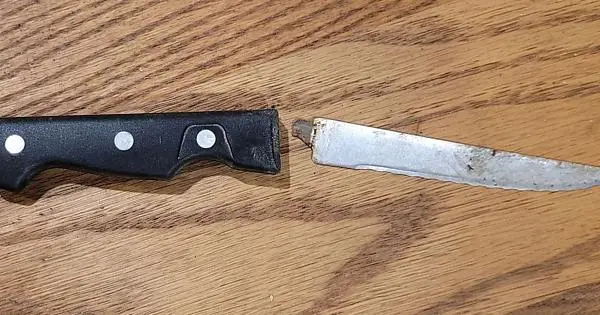I had two basic farberware kitchen knives break in the same way. Both blades had the tang snap back inside the handle. Gluing it back in the grip didn’t work, so I set them aside for a bit.
I have been fixing broken kitchen tools lately, so I decided to replace the handles for both knives.
I started by grinding a new tang into the knife blade. I had to shorten the blade of the knife to do this but my favorite kitchen knives are short, so I don’t think I’ll mind.
Next I turned the first handle on the lathe. I started with a piece of an oak branch I collected after a storm broke it off a tree in a local park three years ago. Several large (up to 8" diameter) branches came down, and the city took their time in cleaning it up. It was good hardwood that would have just been chipped anyways, so we decided to save them some person-hours and gas and went down with a hand saw one night, cut the branches into manageable pieces, and carried most of it home.
Once we got it home, I sealed the ends with wax and stripped the bark with a draw knife so it could dry in the basement. The slow (1 year per inch of material is what I’ve read) drying process seemed impractical at the time but I barely noticed it, getting distracted with other projects.
For these knives and the rubber scraper, I used the smallest of the branches we took.
I When it was ready, I removed it from the lathe, cut away the scrap on either end, sanded either end through all the same grits of sandpaper I used while it was on the lathe, and drilled/cut the slot for the tang.
The second handle took much longer to make - turns out it’s harder to duplicate the dimensions of an existing piece than it is just winging it. That said, there’s a noticeable difference in quality just between these two, so I’m learning as I go at least.
Like the first, I removed it from the lathe and cut away the extra material, and sanded both ends through all the grits of sandpaper I used on the piece while it was on the lathe.
I ground a matching tang into the second blade, drilled and cut the slot into the top of the second handle, and put them together for a test fit.
All in all, I was pleased with the result. The blades fit very tightly, and the handles looked and felt nice enough. The next step was to stain them.
I went for something a little different this time. I coated both with rustoleum black cherry stain I found on trash day, and noticed that certain parts of the wood came through much more red than the purple-brown color of the stain elsewhere. So when I did the second coat, I doubled down on that and used sedona red on the red parts and black cherry on the purple parts, all in the same coat, let them soak in, wiped them down, and let them dry.
I then touched it up with dabs of Red Oak stain and two sharpies, purple and brown.
I finished both handles with two coats of high gloss polyurethane. Once they were dry, I scored each blade on the tang near the end (I wanted a way the glue could grip it better, but found I couldn’t drill through these with my metal bits and only the cutting wheel on the dremel would mark them.) They were already a tight fit, but I wanted to be sure they wouldn’t slip out. Then I glued the blades in place.
I’m still very much an amateur at turning, and am learning as I go, but I’ve always preferred to learn by just doing a project, so getting these broken (fairly cheap) kitchen knives usable enough to return to the kitchen seemed like a good way to practice turning and finishing, and overall I’m pleased with the result.
Those handles look gorgeous, well done
Thank you!
Very cool project! I’ll admit my first thought was “not worth the trouble to fix” but I appreciate being challenged. The final product kept the knives out of a landfill and seem to be working great for you!
Thanks! I think I see it as a bit of a systemic issue and a challenge. I think if something isn’t worth fixing then it wasn’t worth making. But if they already exist and I’ve already got them, it’s up to me to eke as much use out of them as possible (in a lot of my restoration projects my goal is to make stuff worth keeping around).
Now I just have to figure out a use for the handles.



